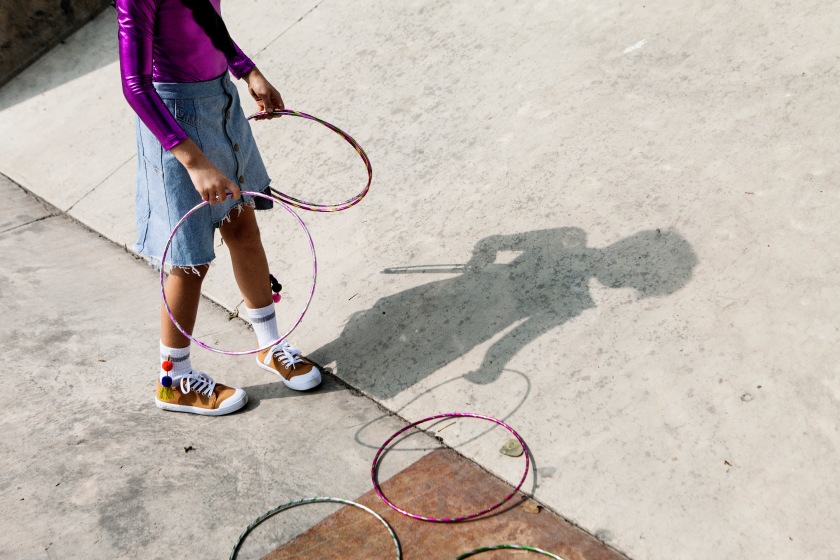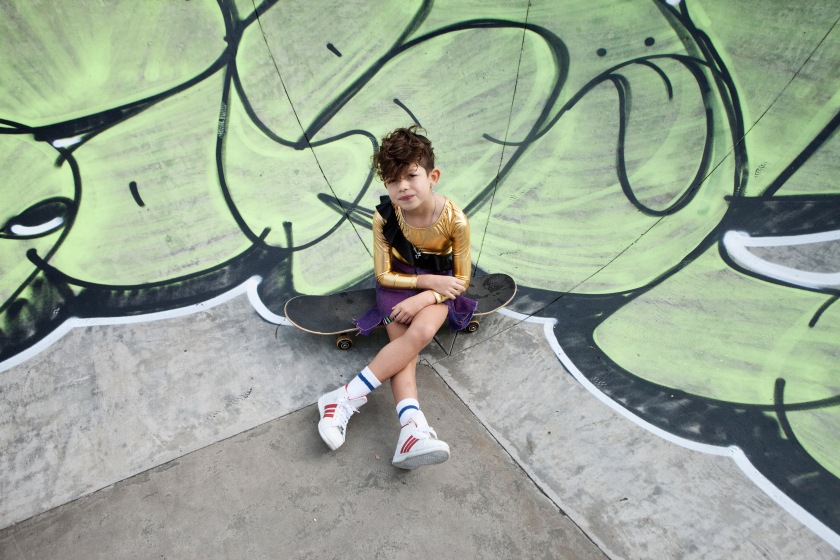clothes you dreamt great-grandma made you

Ace & Jig
Remember when kids’ clothes used to last fashion season to fashion season, one child to the next? When you were just waiting for the chance to become the blissful heir of that long-coveted, breezy, embroidered gauze blouse your older sister would eventually grow out of? And it would reach your hands in rather decent condition, still to be coveted by younger generations of siblings or cousins or neighbors?
It would seem that, these days, the first thing to go is the fabric or the stitching, and then the trend is outdated before your kids even outgrow their clothes (which is already lightning quick, as any parent knows). When was the order of things reversed?
Just as we’re left wondering whether we’re being cheated, why we didn’t notice, in come two girls, one love, to save the day. The love: textiles. The girls: Cary Vaughan and Jenna Wilson. The brand: Ace & Jig.
Boasting a steadily increasing cult following of their women’s collection since 2009, it was only natural that Ace & Jig’s seasonless, timeless, garments would find their way into the children’s market. While the styles have a kimonoesque feel in their straightforward minimalism, the fabrics are intricately engineered on ancient Indian handlooms before they are reproduced on old and antique industrial machines.

Although the term handloom might send a mother running in the opposite direction, seeming at odds with clothing fit for young kids (that is: climbing, wrestling, tugging, and just your basic, general roughhousing), herein lies the secret to durability; there is a very good reason why the ancient Indian looms used to develop Ace & Jig’s yarn-dyed stripes, tartans ad checks, are still around. Far from delicate, this stuff is guaranteed to outlast your kid’s jeans in more ways than one. And, plus, Cary and Jenna, the dynamic duo behind the label, are the proud mothers of their own living, breathing, crash-test dummies. Four under age ten between the two of them.
Refreshingly off-trend yet always smack-on, Ace & Jig is not trying to please anyone but the Goddess of Things Everlasting, managing to do what most designers fear more than anything: create a classic and stick to it, develop it, play with it. Ace & Jig’s nostalgic silhouettes, patterns and color palettes situate you somewhere within a Technicolor-Expressionist-Japanese-Western-Rockwell-Nautical landscape, striking a cool, effortless balance between here and there, between yesterday and tomorrow.

Jenna and Cary plus kids
From the label’s home base in Brooklyn, New York, Cary Vaughan and Jenna Wilson talk textiles, gardenias and India:
GREEN EGGS: How does designing and making the kids’ collection differ from the women’s?
Ace & Jig: So much of our time and love goes into creating our textiles. We spend more time on them than on anything else, and for our kids’ collections we usually use fabric that has been left from our prior seasons, so the textile design work is already done. This means we just get to have fun designing the styles! Coming up with something we think is playful, comfortable, and beautiful.
G.E.: Which is your all-time, best-selling children’s garment? Why do you think it is so popular?
A&J: Our Gardenia Dress from this season definitely takes the cake! It sold out in three out of four colorways the first day we listed it in our webstore, which was exciting and unexpected. Our daughters are both wearing these tons right now.

G.E.: Are your children involved in testing and approving the garments? Do they have a say in the silhouettes, the weave, or color selection?
A&J: Our kids are definitely our first testers of our kids styles. And they are great testers; they are super active and help us make sure our clothes can withstand lots of jumping, running, climbing, and many, many hugs from parents. We don’t usually include them in color selection; if Jig had his way the whole collection would be bold reds! There are a few in there—Big Top and Gridlock—that he would approve of, though.

G.E.: It is easy to imagine that the kids’ pieces start as adult pieces and end up as mini-versions of those. Has the opposite ever happened?
A&J: This hasn’t happened yet! We always design our women’s collection first and the kid’s pieces are often reiterations of some of our favorite pieces from each collection.
G.E.: What is a definite no-no when designing for kids?
A&J: We try not to make anything overly fitted or constricting. Kids are meant to play and get messy! Most of our fabrics can be tossed in the washer and dryer with everything else.
G.E.: You mention on your website that, in your textile development, you work with Indian weavers who enjoy free childcare from their employers and use reclaimed water to grow organic produce, which makes us all feel a lot better about buying products made in places such as India, where we know labor conditions are not exemplary. Tell us about your personal experience finding and working with this community.
A&J: We feel so lucky to have found them! We searched high and low for a place and people skilled enough to help us create the textiles we were dreaming of, and we’ve definitely found them in our Indian partners. We travel there yearly to work one-on-one with weavers on our textiles. It is a beautiful space, and they are a crucial part of the Ace & Jig family. When we’re there we spend tons of time with them, talking textiles, sharing meals—we were even lucky enough to attend one of their weddings in Goa, decked out in gorgeous Indian saris we found at a local market.
G.E.: I always regret not having taken more pictures of young girls in urban India, with their shaved heads and kohl-lined eyes, contrasting with their super-frilly, glittery, lacy outfits. I never was able to bring myself, though, in the six years I lived there, to do the look myself, or to dress my own daughter this way, not even when I had full control over the way she looked! Lately, I’ve seen a lot of gorgeous inspirational images in your Instagram, but they are mostly if not exclusively “Western”. Do you find inspiration in India? If so, what is the process of translating these impressions into the collections? How do you imagine your collections might be like if, for whatever reason or circumstance, India were not part of the equation?
A&J: We find India tremendously inspiring! Each trip we make is such an amazing sensory experience, and the color and vibrancy of Indian culture has certainly made an imprint on our designs. It’s hard to say what the collection would look like without India as inspiration.

G.E.: Have you ever taken your kids on one of your India trips? If not, would you?
A&J: We have not yet but hope to at some point! Perhaps when they are a little older. Currently the length of the trip, combined with the time change and the fact that we are very busy designing and creating whenever we are there, has prevented us from bringing them along.
G.E.: Doing the math, your children must have been very young when Ace & Jig came to fruition in 2009. Which is very recent! What is the secret, because I know there must be one, behind managing both a growing, successful business AND being mom to two kids each?
A&J: There’s no secret! At least not one that we have found. We still struggle to find an ideal work-life balance, but have found it helps immensely to be doing something that brings us joy with people we love.
























